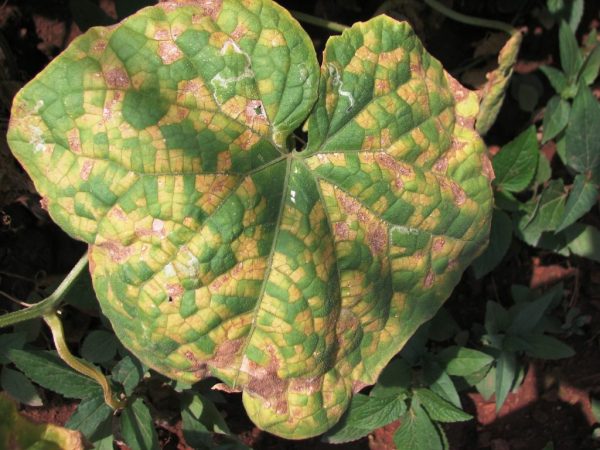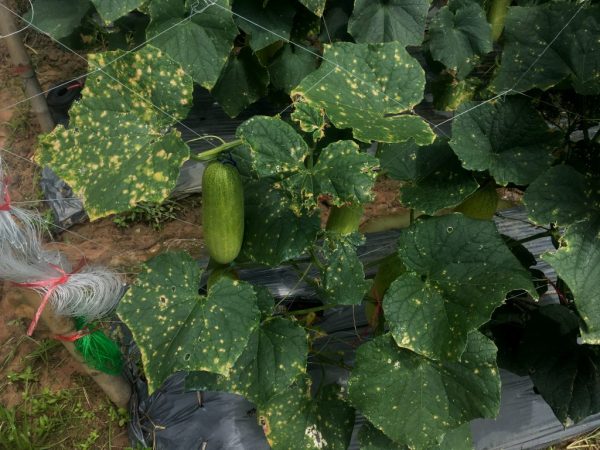Rusty spots on cucumber leaves: causes and treatment
Cucumber is one of the most common vegetable crops. They are unpretentious and fairly easy to care for. But, like all crops, cucumbers are susceptible to disease. And the first sign of the disease is rusty spots on the leaves of cucumbers.

Rusty spots on cucumber leaves
Causes of the problem
Rust on cucumbers is a fungal disease. Fungi are very dangerous. If you do not fight them, they begin to spread very quickly. Fungal spores affect not only the leaves of cucumbers, but also the stems and fruits. In the future, the plant dies.
There are a great many varieties of fungi. In addition to fungi, viruses or mineral deficiencies can cause rust on young cucumbers. We list the types of reasons that occur most often:
- ascochitosis - black rot;
- anthracnose - copperhead;
- peronosparosis - downy mildew;
- cladosporiosis - brown olive spot;
- mosaic;
- lack of potassium;
- lack of magnesium;
- melon aphid;
- spider mite.
Signs of rust on cucumbers
As soon as you notice that rust has appeared on the young leaves of the cucumbers, start treatment immediately.
- Black rot appears as small reddish dots. If the plants are covered with such marks, the leaf curls around the edges a little and changes shape. Gradually the spots fill the entire surface. A sticky liquid escapes from the damaged areas. The seedling dries up and dies. If you do not start treatment, black rot goes to the stems.
- Anthracnose develops at elevated temperatures and high humidity. It develops due to splashing water settling on green plants. The sign is the appearance of rusty spots of the correct rounded shape. If untreated, holes appear at the site of the spots. At the same time, spots appear on the fruit, gradually turning into sores with the release of a reddish liquid.
- Peronosparosis is manifested by the appearance of small yellow spots. Over time, they grow and take on a dark yellow or reddish color. The leaves dry up and the bushes die.
- Corner spotting begins with the appearance of greasy, moist, green spots. Gradually the stains will rust. Over time, they burst and holes form. Fruits also suffer from angular spotting. They become covered with spots and whitish ulcers. The fungus grows best in warm and humid conditions.
- Mosaic disease is manifested by the appearance of yellow, asterisk-like spots. Gradually they grow, the whole leaf turns red and dries up.
- With a lack of potassium, the bush looks healthy, but the edges of the leaves rust slightly and bend.
- The yellowing of the lamellae between the veins indicates a magnesium deficiency.
- When melon aphids appear, the leaves become covered with reddish spots and curl. Then they disappear.
- Spider mites, like aphids, feed on plant sap. Tick colonies are located on the reverse side of the leaf. The leaves are covered with red spots. A white web is visible at the junction with the stem.
Prevention of diseases and pests
Rusty spots on cucumber leaves are easier to prevent than cure. In order for the cucumbers not to get sick, it is enough to follow the basic rules of care:
- disinfect seeds before sowing;
- when choosing a garden, consider the rule of crop rotation;
- loosen the soil in the garden regularly;
- watering carefully, with warm water, trying not to spray water on the bushes;
- do not allow sudden changes in temperature;
- regularly remove weeds from the site;
- when grown indoors, ventilate the room daily to prevent a significant increase in temperature and humidity;
- make preventive spraying, once every 10 days, with a solution of 1 liter of milk, 30 drops of iodine, 20 gr. laundry soap;
- soda solution works well as a preventive measure, dilute soda with water in a ratio of 1:10; they can also water the soil in early June;
- inspect the seedlings regularly.
Treatment of diseases

All diseased parts of the plant must be removed.
Remove all affected parts before treating the bushes with the solution. Pause between waterings for 7 days.
Means for the treatment of fungal diseases can be used both folk and chemical.
Folk remedies
- Take 1 liter of whey, dilute it in 10 liters of water and treat all the plants in the area. If the area is small, then the serum need not be diluted.
- The ash solution not only cures diseases, but is also a wonderful foliar feeding. Take 1 glass of wood ash, pour 2 l. boiling water, leave for 48 hours. Then strain and add 10 gr. laundry soap. Treat the seedling with this solution 2-3 times at intervals of 7 days. With significant damage to cucumbers, the number of sprays is doubled.
- For anthracnose treatment, prepare an onion solution. Take 50 gr. onion husks and 10 liters of water. Boil and leave for 7 days. Process at the rate of 1 liter of solution per 1 bush.
- In case of black leg disease, water the area with a weak solution of manganese.
Chemicals
- In the fight against fungal diseases of cucumbers, Bordeaux 1% liquid has shown itself best. It is necessary to process the green mass 4 times during May and June. In the absence of Bordeaux liquid, a solution of 0.4% copper oxychloride can replace it.
- Treat with Oxyhom, in the amount of 20 grams. preparation for 10 liters of warm water.
- Carry out a single treatment with arceride solution at the rate of 50 g. 10 liters of water.
- For the treatment of anthracnose at an early stage, apply with benomyl and chlorothanil, process according to the instructions.
- To remove the mosaic - destroy the affected plants and treat the soil with 5% formalin solution.
Pest control
Pests are no less dangerous than diseases. Colonies of ticks are capable of destroying all cucumber seedlings for 10 days. Pest control consists of spraying the plants. Spraying must be carried out several times, with an interval of 7-8 days. During this time, females have time to develop and begin to lay eggs.
Means can be used folk and chemical.
Folk remedies
To combat spider mites:
- Make a mixture of 1 kg of potato tops and 10 liters of water. Insist for 4 hours. Moisten all the greens liberally.
- Take 5 liters of dried marigold flowers, fill with warm water, leave for 14 days. Strain, add 40 gr. soap and spray the plants. Spray in the evening.
- Mix 4 kg of tomato tops and 10 liters of water. Put on fire and simmer for 30 minutes. Add 40 gr. laundry soap. Dilute with water 1: 1, spray the plantings generously.
To combat melon aphids:
- Take 1 liter of water, add 1 tablespoon of baking soda and a quarter of a bar of laundry soap. Mix and drizzle over cucumbers.
- Mix 1 kg of chopped hot pepper and 3 liters of water. Boil for 60 minutes. Insist 48 hours. Dissolve 200 ml of infusion in 10 liters of water, add 40 gr. laundry soap.Process the greens.
- Soak 200 gr. dried celandine in 10 liters of water. Insist 48 hours. Strain and spray the planting.
- Make an infusion of 400 g. roots and 600 gr. dandelion greens in 10 liters of water. Incubate for 3 hours.
Chemicals
To combat spider mites, drugs such as:
- Akarin;
- Apollo;
- Intavir;
- Tarnek;
- Spark;
- Fitoverm.
Dilute them according to the instructions.
When choosing varieties for planting, carefully study the section on disease resistance. This will help to avoid further crop loss.


